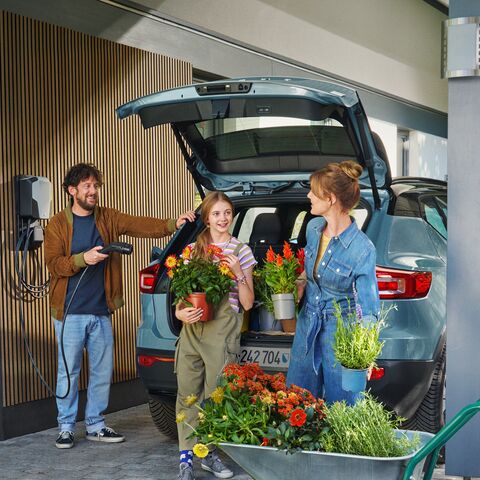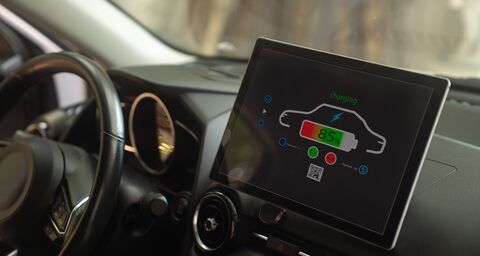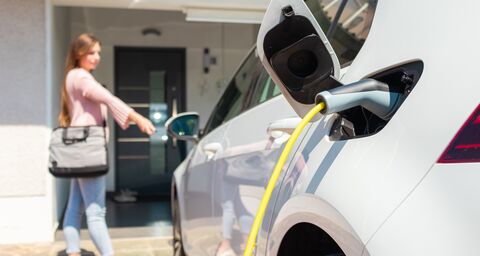
Electric car charging station for your home
Having an EV charging station at home is a practical solution for all electric car owners who want to be less dependent on public charging stations. As opposed to public charging stations, you always have a free parking spot and free charging at home. Here we’ll tell you what it takes to set up a charging station at your house.
How does an EV charge at home?
While you can charge your electric car using a regular wall socket, this should be done only in emergencies rather than on a regular basis. The reason being is that the 2.3 kW supplied by your electrical outlet is not enough to charge your EV in a reasonable amount of time. You could be waiting 15 hours or more depending on the type of electric car battery you have. And the plug isn’t really designed to charge a car, which could present a risk if you use it a lot. Even if you do decide to use your electrical outlet, you should have it inspected by a professional to see whether the cable is safe to use for this purpose.
A better solution is known as a wallbox, a charging station for electric cars that's installed in your home. It is generally mounted on the wall or it can be set up as a freestanding pillar. Depending on the model, it can supply up to 22 kW of power. The charging time will vary on the charging speed of the wallbox and the capacity of the car battery. Depending on the model, a wallbox can take between 2 to 12 hours to fully charge the battery of an electric vehicle.
An at-home charging station not only charges your car, some smart models can also regulate the power supply. Smart wallboxes can optimize the charging time, for instance, by charging the car only up to a certain level in order to avoid wasting energy.
Components of a home charging station
A home charging station for your EV consists of several components.
- Housing: The housing protects the inside components of the charging station and ensures safe installation.
- Charging controls: The charging controls are the key part of a home charging station for electric cars. They regulate the flow of electricity between the electricity source and the electric vehicle and monitor the charging process, ensuring that the car battery isn’t damaged. Modern charging controls generally use smart technology and can automatically adjust the charging speed or limit charging to a certain amount of time, for example.
- Connectors: A charging station has at least one connector that connects the car to the charging station. They are generally a Type 2 connector, which is the standard for EVs in Europe.
- Electricity meter: Many charging stations have built-in electricity meters to measure the amount of electricity charged. You can use the meter to calculate the cost of charging your EV.
- Ground fault current interruption breaker: A GFCI breaker protects the box from electrical surges and is already integrated in many charging stations. It can detect fault currents and interrupts the power supply to protect people and cars.
- Circuit breaker: A circuit breaker protects against overloads and short circuiting and interrupts the supply of electricity if needed.
- Cable: The cable connects the charging station to the electric vehicle. It is usually fixed to the charger and has the appropriate plug on either end.
Advantages of charging your EV from home
You come home from work, plug your car into the charging station and simply let it charge overnight. This way the battery is always charged whenever you need to use it. It also means you are less dependent on public charging stations. Another advantage is the money you’ll save. Public charging stations often charge more than what you pay for charging at home with your wallbox. You can also take advantage of renewable energies, for example if you have solar panels installed at home. And you don’t have to waste time waiting around for your car to charge at a public station.
What you should know when buying a wallbox
You need to make sure you have a suitable power connection. Most charging stations need to connect to a 230-volt grid in order to reach 7.4 kW. A 400 volt power connector will give you charging power output of 11 kW or 22 kW.
The charging power output also tells you whether you will need to get a permit for your new wallbox. You don’t need a permit for up to 11 kW, but you should tell the grid operator about your installation. You must get a permit before installing a wallbox with 22 kW.
Please note: Before you install a fast charging station with a capacity of more than 50 kW in your home, make sure your electric car is actually compatible with this type of charger. Some types of vehicles have especially small batteries that are not suitable for fast charging. The charging station automatically reduces the amount of power delivered, but it will still cost more to charge your car than if you use a wallbox with less output.
Another key aspect is where you put your charging station. Is there an electrical outlet in front of your house or in your garage or will you have to have a new cable put in? The charging station also needs to be located someplace where it’s protected from harsh weather and direct sunlight.
Installing a wallbox also requires technical expertise and experience. For this reason, only electricians with the proper training and certification are allowed to install them. If you try to do this yourself, not only are you risking your own personal safety, but any damage that occurs will not be insured.
Here’s how much the installation will cost
The cost of installing a wallbox will vary depending on your personal situation. The type of charging station, the power connection and the distance to the outlet are all factors that can increase the cost of your installation.
Installation can cost up to CHF 2,000. It may cost even more if you need to have a new cable added to your house, for example.
Our tip: Save on repair costs if you suffer unexpected damages by adding on supplemental “e-mobility charging station” insurance to the policy for your electric vehicle. Then your wallbox has optimal coverage too. If your charging station is damaged, used incorrectly or even stolen, AXA will pay for an equivalent replacement or cover the repair costs.
How the wallbox installation works
If you want to have a wallbox installed, your first step should be to have a professional carry out an on-site inspection. They will check the space and technical specifications. Once you have a permit (if needed), the specialist will lay the necessary cables and install any GFCI and circuit breakers. Walls will often have to be opened up to run the cables. Then the wallbox will be installed and tested. In a final step, the specialist may give you a brief introduction to the new system. Tip: As an AXA customer, you can take advantage of special offers from Swisscharge, such as a 10 percent discount on your new wallbox.
Takeaway: A home charging station is a long-term investment
Having a wallbox electric car charger at home offers a number of advantages over a public charging station. It is more practical, cheaper and, under the right circumstances, even more sustainable.
Overall, electromobility is on the rise and home EV charging stations are a big reason behind this trend. The increased demand for electric cars steps up the demand for charging stations, which means the technology will continue to improve.
Frequently Asked Questions about home charging stations for EVs
What is an electric car charging station for your home?
A wallbox is a charging unit that is specially designed for use in residential garages and carports. It enables EV owners to quickly, safely and conveniently charge their vehicle at home.
How quickly can you charge your car at home?
How fast you can charge your car at home depends on the power rating of your charging station. Most wallboxes supply 11 kW so they take between 4-6 hours to fully charge an EV. There are faster DC charging stations that have a power rating of up to 50 kW that can fully charge a car in about an hour.
Can you use a smartphone or tablet to manage your wallbox?
Yes. Many home EV charging stations can be controlled with an app so you can monitor the charging process and select different settings.






